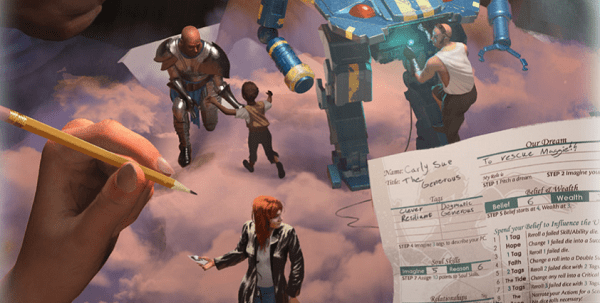GM Tips is our series to help Storytellers and Game Masters improve their craft and create memorable roleplaying experiences. Last week we talked about taking care of your GM after a game and this week we talk about adding some game diversity to your group
When your group finds a gaming home, it can be difficult to convince your team to add in new materials, books, or even try new systems. There are plenty of gaming groups that still calculate their THACO scores. At other times, games struggle with introducing newly printed game material and find themselves dated as the years move on. This is not a negative, far from it, since clearly these groups love what they are playing and have most likely mastered that content.
Fresh game systems and new content can bring in inspiration. A change of pace can even spark nostalgia about what makes your home system so amazing. So what is a storyteller to do when their player base is hesitant to trying new things? D&D is a classic system that has evolved through multiple editions, but what about the Rifts or Savage Worlds games? New RPG games are being launched all the time like Dreamchaser from Imagining Games. Even if you aren’t going to swap systems wholesale, sometimes games like Dreamchaser work as fantastic supplemental material for your chronicle—other times your players may fall in love with a brand new system. Here’s how to get them interested
Alternate Storyteller Weeks

One reason groups never get their mitts on new systems is the weekly grind. Once you’ve settled into a game system that you are playing week-in and week-out the mold is difficult to break. Groups will sometimes try an add a game during the week but it often fails in flames. Shadowrun on Sunday’s and D&D on Thursdays is a lot of time to avoid to gaming during the week. Try an alternating schedule instead. Not only does it give one GM a break, it also keeps the same routine together and the core group moving forward.
Obviously you can alternate schedules and do something like Dreamchaser one week, and Delta Green the next. This works if your players have great memories. I prefer to alternate using short stories. Use a one-sheet adventure or a single night session for one game, and a chronicle (or full campaign) for the other. The brevity of the single sessions allow you to try more content and keep them contained while the campaign can provide the larger attachment. Several times, these one-shot games have found themselves interwoven together to build a larger storyline. Events like this will naturally happen when you start alternating.
Add Favorite Elements Into Your Current Game
I love the Dread game system, and I’m pretty fond of Dreamchaser’s plotting elements, but my players have bought in heavily to D&D Beyond. As a group of veteran gamers, I’m lucky that my player’s have gotten a chance to sample multiple systems over the years, but every group settles on a system. The Legend of The Five Rings was run for ages and we found the game even better by adding in story lines from Shadowrun. That the ruined wastelands outside of the Emerald Empire were really corporate toxic waste. The subtle drop and a hint of that flavor text made for great out of game conspiracy theories, but also paved the way for us to run Shadowrun after the L5R game folded.
Taking games like Dread and putting them into your D&D game can be incredibly effective at adding danger to an environmental threat. When you perform a calculated merge for a single event, you can showcase strong elements from another system to players—especially since settings often have their unique lore. Using a Deadlands chip system when your Shadowrun players leave Seattle and head to Colorado can create a mental reminder that they’ve journeyed. Still, you can’t go overboard with this tip. Keep your system merging to singular boss fights, or one-off encounter building less it becomes more cumbersome for everyone involved.
Sidequest Your Current Campaign

With no gimmicks, no schedule swapping, and no merging of game systems there is a third and final way to get your players attempting new game systems—sidequests. There’s a solid chance all our games have truly become perpetual sidequest machines already as players ignore the carefully catered plot, so let’s have fun with it. When you’ve got a very clear side quest or branching path in your campaign, invite the players to take this quest on using a new system but the same characters.
Building their existing PC’s into a new system helps prevent information overload. It’s also rather exciting to recreate a character using new rules sets. Trying to build a Barbarian from D&D into a Gangrel Berserker for Vampire: The Masquerade is a fun endeavor. When the characters sidequest, they earn rewards and develop their story arcs while learning the new system at the same time. Since learning through play is the foundation of demo’s at conventions, this sidequest method is my favorite.
In one game we had a Rifts Battletech storyline where we roleplayed the pilots and then used the Warhammer 40k system with mini’s for off world combat and a few narrative sidequests. Since I’m not a miniatures player, I never would have attempted the game without the tie back to my Rifts game.
How often does your group try out new systems? Let us know in the comments below!
MORE RPG GOODNESS
- Matt Colville’s new D&D campaign has a custom class!
- The Mountain Goats are in League with Dragons
- The Beauty of D&D Is In The Eye Of The Beholder
Featured Image by: Dreamchaser RPG
Image Credits: Dreamchaser RPG
Rick Heinz is the author of The Seventh Age: Dawn, and a storyteller with a focus on LARPs, Wraith: The Oblivion, Eclipse Phase, and many more. You can follow game or urban fantasy related thingies on Twitter or Facebook.